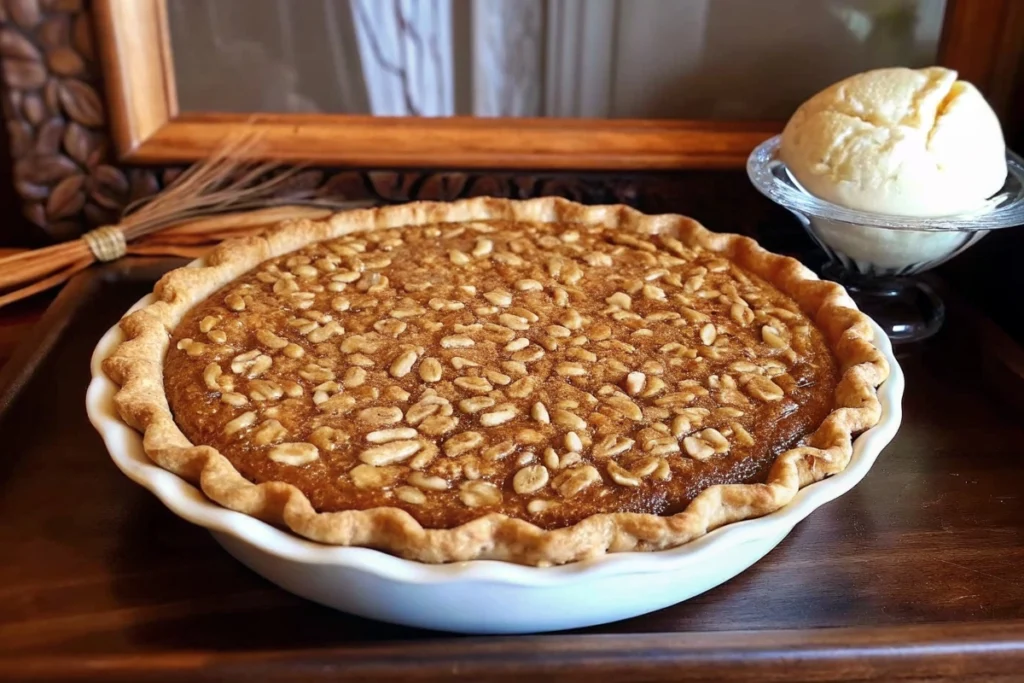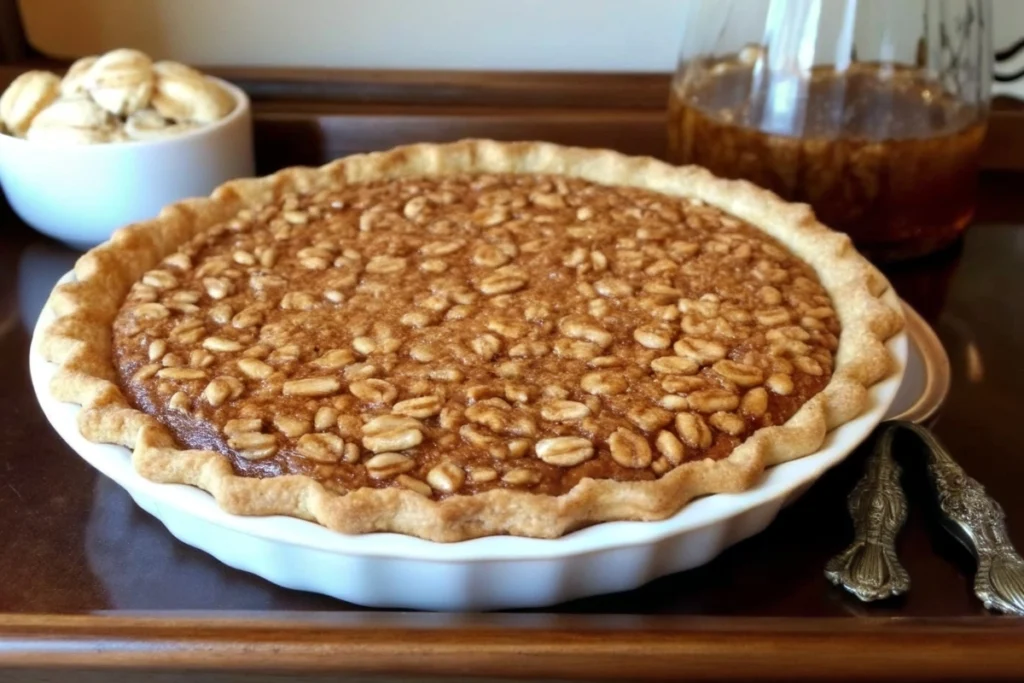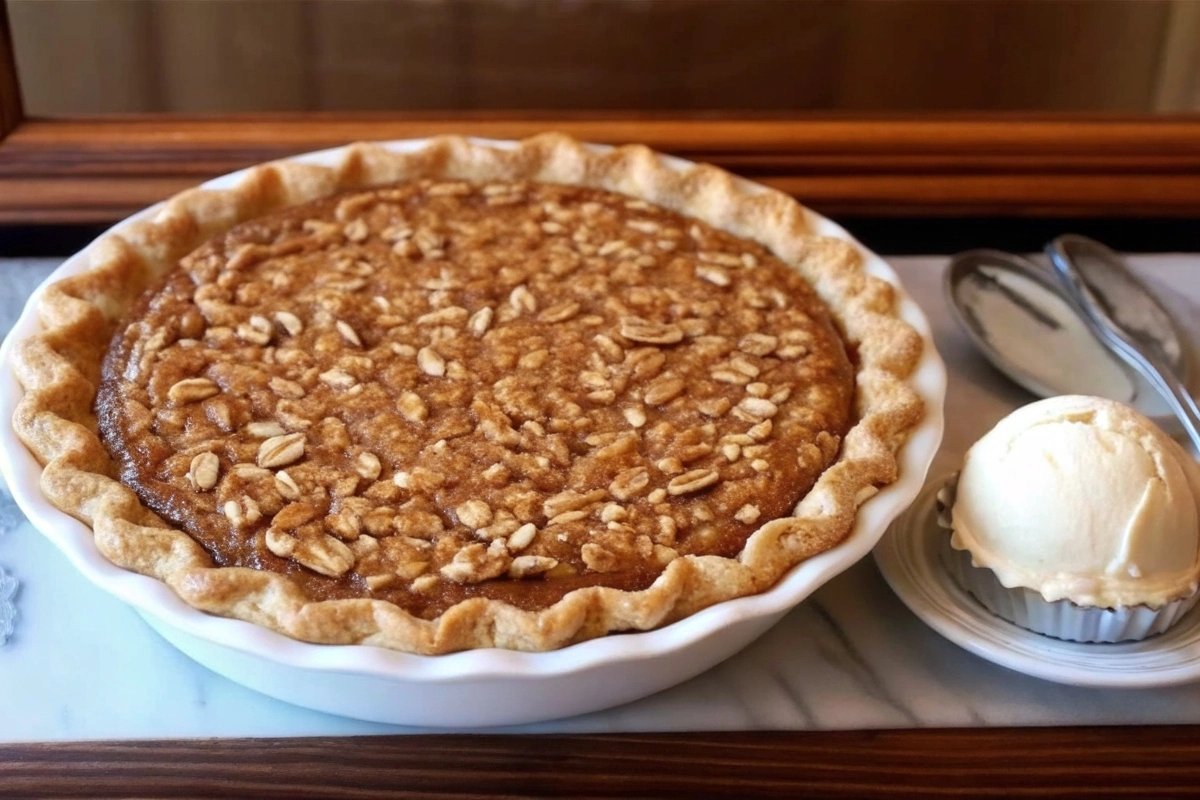Introduction and Overview
The moment you uncover your oven’s door and breathe in the warm, homely aroma of freshly baked Amish Oatmeal Pie, you’ll understand why this rustic dessert has captured hearts for generations. Originating from tight‑knit communities that prized simplicity and sustenance, this pie marries a tender, buttery crust with a hearty, sweet oatmeal filling that comforts and delights. In this article, we’ll explore the roots of this time‑honored treat, break down every component, and guide you through a foolproof recipe. Whether you’re a seasoned baker or a curious novice, you’ll finish reading armed with insights, tips, and variations to make your own Amish Oatmeal Pie a show‑stopping favorite at any gathering.
What Is Amish Oatmeal Pie?
At its core, Amish Oatmeal Pie is a delightful reinterpretation of the classic pecan‑style pie, swapping nuts for the gentle chew of rolled oats. Rather than relying on heavy creams or complex fillings, this pie leans on pantry staples—butter, sugar, eggs, and oats—to create a custard‑like interior that sets with a subtle, caramelized sweetness.
- Texture: Smooth yet slightly toothsome, thanks to the oats
- Flavor: Warm, buttery notes elevated by vanilla and cinnamon
- Ease: A straightforward recipe suitable for bakers of all levels
For context on the broader culinary tradition, see Amish cuisine, which emphasizes hearty, unfussy dishes rooted in community and resourcefulness.
History and Origins (Pennsylvania Dutch Roots)
Amish settlers, arriving in Pennsylvania in the early 18th century, brought with them Old World traditions that evolved on American soil. While many associate the community with shoofly pie or whoopie pies, the emergence of an oatmeal‑based dessert speaks to both frugality and ingenuity.
- Adaptation: Early bakers substituted expensive nuts with locally grown oats
- Evolution: Techniques refined over decades, balancing oats with a sweet, custardy binder
- Regional Spread: From rural homesteads to church potlucks across the Midwest
The star ingredient, oatmeal, was once a daily staple—economical, nutritious, and filling. By incorporating it into desserts, Amish cooks honored tradition while treating families to something special.
Key Ingredients and Their Roles
Understanding each component ensures consistent results. Here’s what you’ll need and why:
- Rolled oats: Provide structure and that signature chew
- Butter: Adds richness and helps the filling set smoothly
- Sugar: Sweetens and caramelizes during baking
- Eggs: Bind ingredients and create a custard‑like texture
- Flour: Stabilizes the mixture and prevents separation
- Vanilla extract: Enhances overall aroma and depth
- Cinnamon (optional): Introduces a warm, spicy note
Tip: Use high‑quality vanilla and fresh oats for the most vibrant flavor.

Equipment and Tools Needed
Equip your kitchen with the right tools to streamline the process:
- 9‑inch pie pan (standard or deep‑dish)
- Mixing bowls (one large, one medium)
- Whisk and rubber spatula for smooth integration
- A rolling pin for evenly flattening dough
- Pastry brush (for egg wash, if desired)
Having everything prepped and within reach will keep the workflow smooth and stress‑free.
Step‑by‑Step Recipe Instructions
- Prepare the Crust
- In a large bowl, combine 1¼ cups all‑purpose flour, ½ teaspoon salt, and ½ cup (1 stick) cold butter cut into cubes.
- Use a pastry cutter or your fingertips to blend until the mixture resembles coarse crumbs.
- Add 2–3 tablespoons ice water, a tablespoon at a time, until dough forms.
- Shape into a disk, wrap in plastic, and chill for at least 30 minutes.
- Roll and Pre‑Bake
- Preheat oven to 375°F (190°C).
- On a lightly floured surface, roll dough to a 12‑inch circle.
- Gently transfer to a 9‑inch pie pan, trim excess, and flute edges.
- Prick the bottom with a fork and blind‑bake for 10 minutes.
- Craft the Filling
- In a medium bowl, whisk together:
- 1 cup rolled oats
- ¾ cup granulated sugar
- ½ cup melted butter
- 2 large eggs, beaten
- 1 tablespoon vanilla extract
- 2 tablespoons all‑purpose flour
- ½ teaspoon ground cinnamon (optional)
- Stir until the mixture is smooth and oats are fully coated.
- In a medium bowl, whisk together:
- Assemble and Bake
- Pour filling into the pre‑baked crust.
- Bake at 375°F (190°C) for 35–40 minutes, or until the center is nearly set (it will firm up as it cools).
- If edges brown too quickly, tent with foil.
- Cool and Serve
- Allow the pie to cool on a wire rack for at least 2 hours.
- Slice and serve at room temperature or chilled.

Variations and Flavor Twists
- Maple‑Brown Sugar Oatmeal Pie: Replace granulated sugar with ½ cup brown sugar and ¼ cup pure maple syrup.
- Nutty Add‑Ins: Stir in ½ cup chopped pecans or walnuts for crunch.
- Dried Fruit Boost: Fold in ¼ cup raisins or dried cranberries for chew and color.
Experiment to discover your favorite spin on this classic.
Tips, Tricks, and Troubleshooting Common Issues
- Soggy Bottom: Ensure the crust is fully blind‑baked and oats are well mixed in the filling.
- Over‑browned Edges: Use a foil shield around the crust rim halfway through baking.
- Undercooked Center: Extend bake time in 5‑minute increments; look for a slight jiggle in the filling rather than liquid.
- Dense Texture: Don’t over‑pack oats; measure by spooning flour into the cup gently.
Serving Suggestions and Pairings
- A dollop of whipped cream or a scoop of vanilla ice cream complements the warm, sweet filling.
- Serve alongside a steaming cup of coffee, chai latte, or herbal tea to balance richness.
- Garnish with a sprinkle of cinnamon or a few toasted oats for visual appeal.
Storage, Make‑Ahead, and Reheating Guidance
- Room Temperature: Keep covered at room temperature for up to 2 days.
- Refrigeration: Store in an airtight container for up to 5 days.
- Freezing: Wrap individual slices in plastic wrap and aluminum foil; freeze up to 3 months.
- Reheating: Warm slices in a 325°F (160°C) oven for 10–12 minutes or microwave for 20–30 seconds.
Frequently Asked Questions
- Can I use quick‑cooking oats instead of rolled oats?
Quick oats absorb liquid more rapidly and can lead to a mushier texture. For best results, stick with rolled oats. - How do I tell when the pie is fully set?
The filling should look mostly firm with a slight jiggle in the center. It will finish setting as it cools. - What’s the best way to transport this pie for potlucks?
Chill completely, then carry in a sturdy pie carrier or shallow box. Place on a flat surface to avoid sloshing. - Is there a gluten‑free adaptation?
Substitute a gluten‑free flour blend for the crust and ensure oats are certified gluten‑free. - How far in advance can I bake and still maintain texture?
Bake up to 24 hours ahead; store at room temperature, then slice and serve. For longer storage, refrigerate.
Conclusion and Encouragement to Try Amish Oatmeal Pie
Simplicity, tradition, and heartwarming flavor converge in every slice of Amish Oatmeal Pie. By following these steps and tips, you’ll create a dessert that resonates with the legacy of Pennsylvania Dutch kitchens and invites new memories at your table. Gather your ingredients, preheat that oven, and savor the delight of homemade, old‑fashioned goodness. Enjoy!

